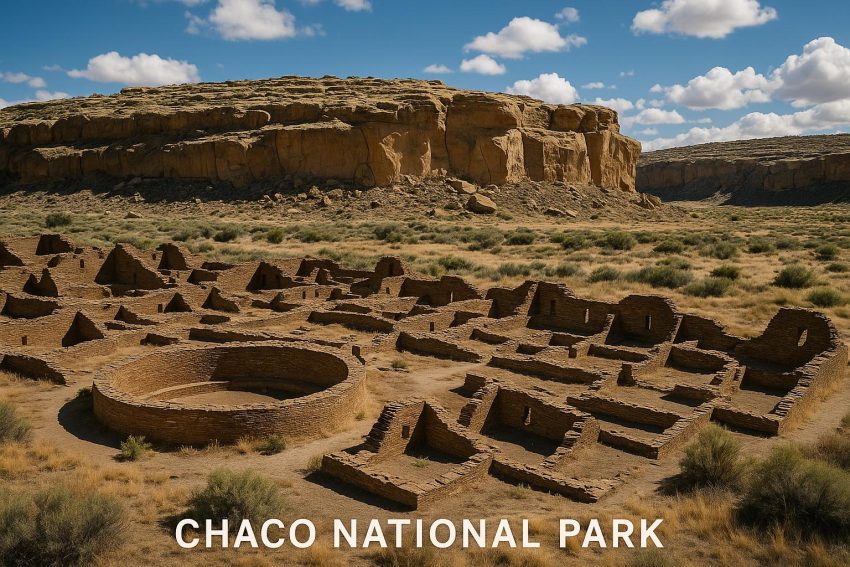Chaco National Park: A Historical and Archaeological Overview
Chaco National Park, located in the northwestern region of New Mexico, is an exceptional destination for those with an interest in ancient cultures and archaeological marvels. The park serves as a significant historical repository, offering a unique window into the lives of the Ancestral Puebloans, a civilization that thrived in the area from around AD 900 to 1150.
Geographical Setting
Nestled within a remote canyon carved by the Chaco Wash, Chaco National Park is a part of the broader Chaco Culture National Historical Park. The park is typified by its rugged mesas and steep-sided canyons, as well as its distinctive high desert environment. This arid and remote landscape enhances the allure and mystique of the ancient ruins scattered throughout the park.
Key Features of Chaco National Park
The central attractions of Chaco National Park include its collection of enormous stone edifices, commonly referred to as “Great Houses.” These structures serve as a testament to the architectural prowess and engineering skill possessed by the Ancestral Puebloans. The Great Houses are remarkable not only for their sheer size and intricate layouts but also for their precise alignment with astronomical events.
Notable Structures: Chaco National Park is home to a number of notable archaeological sites. Among them, Pueblo Bonito stands out as the largest Great House, initially reaching heights of four or five stories and comprising over 600 rooms. Another significant structure is Casa Rinconada, which is renowned for its grand kiva, a large ceremonial space of great importance.
Roads and Alignments: The Chacoans engineered an extensive and sophisticated network of roads that linked their various settlements. These pathways, often characterized by their remarkable straightness, underscore the high level of planning and organization inherent in the Chacoan culture.
Astronomical Significance
Chaco Canyon was not merely a collection of elaborate buildings; it functioned as a central cultural and ceremonial hub. Many structures within the park are aligned with astronomical phenomena, such as solstices and equinoxes, indicating that the Chacoans had a profound understanding of celestial events. The Sun Dagger, an ingenious arrangement of rocks used to signify the summer solstice, stands as one of the most well-known examples of this astronomical alignment.
Preservation Efforts and Visitor Information
The ongoing protection and preservation of Chaco National Park are of critical importance, as the site remains a vital source of insights into the Ancestral Puebloan culture. Visitors to the park are encouraged to adhere to the guidelines prescribed by the National Park Service, which are designed to assist in the conservation of this invaluable cultural heritage.
For additional information regarding visiting the site, or to learn more about upcoming events and ongoing preservation initiatives, interested individuals are advised to consult the official National Park Service website.
Chaco National Park stands as one of the most significant archaeological sites in the United States. It offers a unique lens through which the lives and achievements of one of North America’s most captivating ancient cultures can be explored and understood.
Understanding the Ancestral Puebloans
The Ancestral Puebloans, also known as the Anasazi, were a Native American culture that inhabited the Four Corners region of the United States, where Arizona, Utah, Colorado, and New Mexico meet. The civilization is noted for its sophisticated architectural techniques, intricate social structures, and profound understanding of astronomy, elements that are vividly captured at Chaco National Park.
Social and Cultural Insights
The social structure of the Ancestral Puebloans is believed to have been complex, with an emphasis on communal living and shared resources. The Great Houses in Chaco likely served not only as residences but also as centers for religious and social gatherings, amplifying their significance as cultural and ceremonial epicenters. The enormous size and elaborate design of such structures suggest a highly organized society capable of orchestrating large-scale construction projects.
Astronomy and Architecture
The integration of astronomical observations with architectural planning is one of the hallmarks of the Chacoan civilization. The precise alignment of buildings with solar and lunar cycles allowed the Ancestral Puebloans to track celestial events meticulously. These observations would have been critical for agricultural planning, including determining the best times for planting and harvesting.
Key Observational Tools: The Ancestral Puebloans utilized various natural formations and constructed features to study astronomical phenomena. Beyond the Sun Dagger, other noteworthy examples include specific rock formations and the alignment of ceremonial buildings, serving as ancient observatories that facilitated detailed celestial tracking.
Chaco Canyon’s Environmental Challenges
Despite its prominence as a cultural hub, the environmental conditions of Chaco Canyon posed significant challenges. The arid climate, limited water sources, and harsh terrain required the Chacoans to develop advanced agricultural and resource management techniques. The construction of water control systems, such as dams and reservoirs, illustrates their ability to adapt and thrive within this unforgiving environment.
The Legacy of Chaco National Park
Today, Chaco National Park remains a testament to the ingenuity and resilience of the Ancestral Puebloans. Ongoing archaeological research continues to unveil new insights into this ancient civilization, enriching our understanding of their way of life and cultural achievements. Efforts to conserve and study the park ensure that future generations will be able to explore and appreciate the enduring legacy of the Chacoans.
For those interested in further exploration of Chaco National Park, detailed maps, visitor information, and educational resources are available through various channels, providing valuable insights into this remarkable slice of history. The park’s official website is an excellent starting point for planning a visit or engaging in deeper research.
Through its enduring architecture, intricate social systems, and profound astronomical insights, Chaco National Park offers a captivating glimpse into the past, enabling a deeper appreciation for the complexities of ancient Puebloan society and the enduring human spirit.

